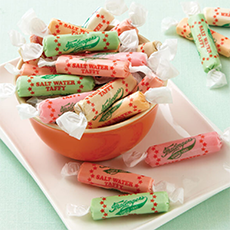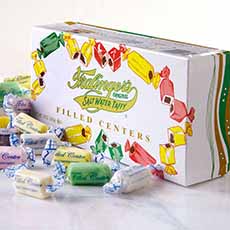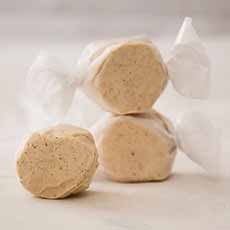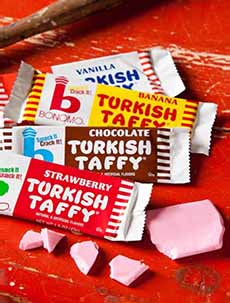Salt Water Taffy History For National Taffy Day
|
|
National Taffy Day is upcoming on May 23rd. Taffy, a soft chewy candy you can pull apart, has been around since the early 19th century. The flavors, originally plain molasses or sugar, evolved into an assortment of basic fruits, chocolate, vanilla and peppermint. Today, that handful of flavors have grown to more than 80+ flavors at Taffy Town alone. There is just about any flavor you could desire, including passion fruit, piña colada and strawberry cheesecake. There are even “savory” flavors like buttered popcorn, chicken & waffles and pickle. How about X-Treme Hot Taffy? Taffy was (and is) simple to made from brown sugar or molasses and butter, and then with different flavors mixed in. Today, corn syrup might be added to prevent crystallization. With the advent of the flavors, the taffy, originally white-beige, was colored to match. The taffy is stretched or pulled for 20 minutes or so, and rolled into ropes. The ropes are cut into pieces no longer than two inches, and wrapped in wax paper or cellophane, twisted at each end, to keep the taffy soft. Today’s taffy is available in three shapes: the “original” oblong-shape (photo #1) and round shape (photos #6 and #7). The history of taffy is below. One of the first Atlantic City salt water taffy brands, Fralinger’s, sells the original taffy plus modern variations: The history of salt water taffy begins now, and the history of Turkish taffy is below. Generations upon generations of Americans have enjoyed taffy. In the 1840s candy pulls became popular, and were called taffy pulls by the late 1870s. Taffy pulls entertained young and old alike. Here’s more about it. Here’s how to host your own taffy pull (and here’s the difference between taffy and toffee). They were also a suitable face-to-face pastime for courting couples (in those days, a husband didn’t even kiss the bride until they had been pronounced man and wife). By the 1880s, “salt water” taffy, in small pastel-colored oblongs wrapped in wax paper, had become associated with the Atlantic City Boardwalk. A box taffy became the iconic souvenir. First, let us say that there is no salt water in salt water taffy, although regular tap water is required to make the product. From where came the name salt water taffy? Here’s what we do know: Around 1880, the Ritchie Brothers and Windle W. Hollis both had taffy stands on the Atlantic City Boardwalk. Taffy was the candy sensation of the day, a must-have vacation treat for children and adults alike. The reigning story is that a storm flooded the shop of a taffy vendor. Was it Ritchie? Hollis? Someone else? We don’t know. At the end of the summer of 1884, Captain John L. Young approached Joseph Fralinger, a local vendor whose various stands sold cider, fruit, lemonade, mineral water and a storefront with cigars. Young wanted Fralinger to take over the taffy stand on the Applegate Pier. Fralinger agreed and in the winter of 1885, he read books on confections, selling his first batch of taffy that spring. His first flavors were molasses, chocolate, and vanilla. More flavors followed, culminating in 25 different choices and color variations. According to an account in Wikipedia, Fralinger was standing at the booth of another taffy maker, David Bradley, who had been selling taffy since 1883 and to whom the anecdotes credit with the “storm” story. Fralinger heard one young girl ask for “salt water taffy,” another ask for “ocean wave taffy” and a third ask for “sea foam taffy.” Fralinger deduced that they were not asking for particular flavors, but simply giving their own creative names to the taffy sold on the Boardwalk. The “storm” fable, subsequently created by Bradley, told of a Nor’Easter storm that sprayed the ocean water over Mr. Bradley’s stock of taffy. Fralinger recognized a concept when he heard it. He had already been selling boxes of taffy. He took the next step and popularized the name “salt water taffy,” printing boxes with that name and selling it as a souvenir of Atlantic City (photo #2). Here’s an account from his great-grandson, including many more details and how taffy was pulled. According to the account, in 1923 another vendor obtained a trademark for the name “Salt Water Taffy” and attempted to get fees from anyone else using the name. The case went all the way to the U.S. Supreme Court, which ruled against him on the grounds that the name had been used by too many people for too long for any one person to claim any exclusive rights to it. Fralinger produced taffy in small oblongs. His first major competitor, Enoch James, made his taffy into bite-size rounds. Both shops still operate on the Atlantic City Boardwalk. The first mention of “salt water taffy” in an Atlantic City business directory dates to 1889. James Candy Company, an Atlantic City taffy maker established in 1880, markets the Fralinger brand today. Oblong or round, the older the taffy, the harder it gets. If you value your fillings, pinch a piece before you chew it. It should yield to pressure, like a ripe pear. Otherwise, you might want to remove the wax paper and nuke it for 3 seconds in the microwave. In the early 20th century, Turkish Taffy bars, the size of chocolate bars, appeared (and later, a jumbo bar was made for souvenir shops). Many citations state that Turkish Taffy was invented by Victor Bonomo shortly after World War II. But according to the Bonomo Turkish Taffy Museum, Turkish Taffy was invented in 1912 by an Austrian immigrant, Herman “Pop” Herer. In 1901 he started his own wholesale candy-making business. While making a batch of marshmallow candy for M. Schwarz & Sons of Newark, New Jersey, Pop accidentally added too many egg whites to the batch. He recognized that the result had potential; and after much experimentation, he created, “Turkish Taffy.” |
|
|
Why he chose that name is not recorded; however, our guess is that he may have been inspired by the Turkish confection known as Turkish Delight. Later, Pop’s business was purchased by M. Schwarz & Sons, and Pop went to work for them perfecting his Turkish Taffy. M. Schwarz & Sons renamed the product Turkish Chewing Taffy. In 1936 the Bonomo family of Coney Island in Brooklyn, New York purchased M. Schwarz & Sons’ Turkish Chewing Taffy. They dropped the word “Chewing” and the treat returned to its original name, Turkish Taffy—a name trademarked by Bonomo. Coincidentally, the Bonomo family was of Turkish ancestry. What Bonomo and its taffy bar imitators make is technically not taffy, but short nougat. The bars are made from a batter of corn syrup and egg whites that is cooked and then baked. Taffy bars are harder and tougher to chew than salt water taffy. The way to eat Bonomo’s was to smack the wrapped bar against a hard surface to crack it into individual pieces. The pieces were chewed over a period of time, so the bar lasted longer than an individual piece of salt water taffy. In 1972, the Bonomo brand was purchased by Tootsie Roll Industries, which changed the 60-year-old smack-it crack-it formula to a soft taffy, eventually named Soft and Chewy Tootsie Taffy. It did not do so well, and by the mid-1980’s the product was discontinued. After petitions by fans, the original Bonomo Turkish Taffy was relaunched in 2010—in the original flavors, vanilla, chocolate, strawberry, and banana. So…should you go for salt water taffy or Turkish Taffy? Personally, we opt for the softer, chewier, salt water taffy. And on National Taffy Day, we’re going to dig into a box of it. CHECK OUT WHAT’S HAPPENING ON OUR HOME PAGE, THENIBBLE.COM.
|
||










